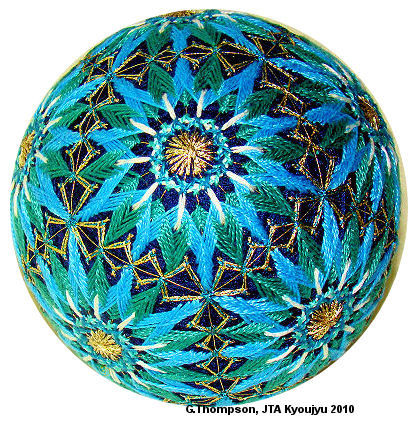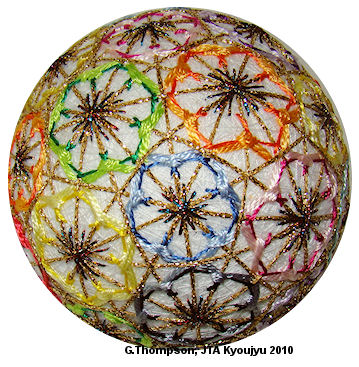Temari (in Japanese
writing,てまり) - "te"
means hand, and "mari"
means ball - is an ancient folk art form. The Japan Temari
Association provides the history of Temari as originating from
Kemari (a football/kickball type game), originally coming from
China during the Asuka Period (538 to 710). The balls were
originally made from deer hide. During the Edo Period (1603 to
1867), women in the Royal Court evolved Kemari to Onna Mari
(which then became Temari), and would make brightly colored
balls for the little girls. More gentle games of rolling and
tossing Temari emerged. The ladies also used Temari making as an
opportunity to perfect and show off (even competing) their kagari (kagari means
"stitch", noun and verb), to gain the attention and favor
of their favorite princes.  Temari
were at first made with kakagari
(stitch with silk threads), and limited to the upper classes.
However, when cotton threads became more easily available common
people began making them using cotton (and others such as linen,
wool, etc.) thread. This allowed Temari to be made by many women
in all areas of Japan (and for them to become favored toys for
children), and each prefecture or area established its own
recognizable and known style, based on local culture and
materials. Temari is a traditional, highly artistic culture and
skill in that each design shows the unique characteristics of
the maker's free ideas and creativity. (With
thanks to the Japan Temari Association)
Temari
were at first made with kakagari
(stitch with silk threads), and limited to the upper classes.
However, when cotton threads became more easily available common
people began making them using cotton (and others such as linen,
wool, etc.) thread. This allowed Temari to be made by many women
in all areas of Japan (and for them to become favored toys for
children), and each prefecture or area established its own
recognizable and known style, based on local culture and
materials. Temari is a traditional, highly artistic culture and
skill in that each design shows the unique characteristics of
the maker's free ideas and creativity. (With
thanks to the Japan Temari Association)
Temari were/are made from previously used materials: discarded clothing and household items were taken apart, and as much as possible the fabric pieces and threads would be saved and reused (for many purposes). Materials from nature were also used. The earliest known was most likely deer hide, stuffed with pine needles and then sewn together. Later on pieces of fabric would be used. Regardless of material, the process is the same: a core filling is wadded into the shape of a ball, then wrapped with strips of fabric and then thread. The ball would then be firmly stitched together (it is said that the balls were wrapped and stitched so tightly that they actually did bounce). It became traditional for Temari made as toys to have some rice, pebbles, etc. in their center to make them rattle; modern ones may have a bell or similar rattle in their centers for good luck. Japanese aesthetic requires beauty in all things, so it was natural that creation of Temari became an art, with the functional stitching more and more decorative and detailed, until the balls displayed very intricate embroidery. Temari wholly transcended from play toys into art objects (although loving moms will still make them for their children) with the introduction of rubber to Japan (rubber balls to tend to bounce so much better, regardless of how tightly the Temari would be packed).
Temari now represent a
highly valued and cherished gift, symbolizing deep friendship
and loyalty, and wishing good luck. It is traditional for a
mother to make a ball for her daughter as a New Year's gift.
They are also often given as gifts on auspicious occasions.
Filled with both the craftsman's gentle spirit and skill, Temari
are believed to bestow happiness. The brilliant color and
threads used also are symbolic of wishing the recipient a
brilliant (happy) life. Traditionally, becoming a craftsman in
Japan was a  long
and tedious process, beginning very early in life. You would be
handed off to a master, and do nothing but watch your master
while performing servant duties in the workshop for the first
forty years, learning everything you can by observing - but
being taught nothing. If the master feels you are sincere after
forty years of humbling effort, you will be accepted to
apprentice for the next thirty years, repeating over and over
the patterns and designs the master has made - but never being
allowed to create your own designs. It will only be after the
master dies that you can then be acknowledged as a master, if
you have proved yourself. To become a Temari artist in Japan
today requires specific training and examination, spanning
upwards of ten years to complete all certification levels (and
yet also patterning, relatively speaking, after the apprentice
time frame). Certification is administrated and managed by the
Japan Temari Association in Tokyo, Japan.
long
and tedious process, beginning very early in life. You would be
handed off to a master, and do nothing but watch your master
while performing servant duties in the workshop for the first
forty years, learning everything you can by observing - but
being taught nothing. If the master feels you are sincere after
forty years of humbling effort, you will be accepted to
apprentice for the next thirty years, repeating over and over
the patterns and designs the master has made - but never being
allowed to create your own designs. It will only be after the
master dies that you can then be acknowledged as a master, if
you have proved yourself. To become a Temari artist in Japan
today requires specific training and examination, spanning
upwards of ten years to complete all certification levels (and
yet also patterning, relatively speaking, after the apprentice
time frame). Certification is administrated and managed by the
Japan Temari Association in Tokyo, Japan.
Patterns seen in
Temari are often geometric and usually symmetrical, with many of
the design elements being based upon nature. In appearance, most
are very reminiscent of a kaleidoscope's patterns. Designs are
formed either by their own patterns, or by the "negative (or
white)" space image that is left once the pattern is stitched.
Westerners will often look at a temari from the side and see a
lovely upper and lower design with a wide band through the
middle. Those of the east will look directly at the top or
bottom and see the image of petals created by the space where
the thread does not cover. Some of the most beautiful designs in
temari use very few threads.
Sizing of Temari is as varied as the crafter. Any size is possible and larger ones are popular in Japan, where collections of all sizes and styles are treasured. Smaller ones may be made for personal accessories including jewelry. They may be displayed singly or collected and arranged in groups. Display styles may include hanging arrangements or multi-tiered tabletop displays. They make wonderful, unique gifts, treasured as wedding and anniversary gifts, and as mementos of friendship and special occasions.
Last updated 1/2014 © All content Copyright 1998 - 2014 inclusive; Ginny Thompson and Puffin Stuff, Inc., et. al. All rights reserved; no portion of this site may be reproduced, republished or used for profit without expressed written permission of the author/website owner and contributors, unless otherwise indicated on individual pages. Individuals may download one copy for private, non-profit use only. The Japanese version of TemariKai.com is made available by permission to and through the translation services of Ai M.; full copyright protection and limits extend to the Japanese version.

